#drainage canal dig
Text
New: Thieves dig nearly $1m in jewellery and cash out of Philippines mall
In a daring heist, thieves tunneled into Gaisano Mall in Ozamiz City, Philippines, making off with 41 million pesos in jewelry and cash. Commencing their covert operation in a carnival beside the mall, the trio dug through a drainage canal to access the mall’s food court.
Social Media Links
Follow us on:
Instagram
Threads
Facebook
Twitter
YouTube
DailyMotion
Read More News…

View On WordPress
0 notes
Text
Black Cat!Wanderer, who you find in an alleyway behind your apartment complex, badly bruised and barely conscious. He's poorly dressed, even for a hybrid, shivering and deathly pale, but he still finds the strength to snap at you as you approach him. You have to bribe him with fish you can't afford and a blanket nicer than anything you'd buy for yourself before he lets you so much as touch him, and even then, he's quick to growl and tell you to get away from him as soon as you try to pet him. He's a temperamental kitten, but considering the state he's in, you can't say you blame him for being so defensive.
Black Cat!Wanderer, who lets himself into your apartment after a few weeks of alleyway visits and offered meals. He doesn't scratch at your door or ask to come in. You find him splayed out on your couch when you get home, muttering that it'd been too long since the last time he saw you and scowling into a clawed-up pillow. He still comes and goes as he pleases (you wouldn't try to keep a hybrid so clearly used to being on his own contained), but he spends most of his time curled up on your bed or trailing after you around the house, still pretending he'd rather be anywhere on earth other than in your lap. He says that you're just like every other human, that he only hangs around you for the food and a warm place to sleep, but the way he purrs when you scratch at his ears says otherwise.
Black Cat!Wanderer, who doesn't just visit you at home, either. He always seemed to ""coincidentally"" be passing by your office just in time to walk you home from work, and doesn't seem to consider a quick grocery run or shopping trip to be a good enough excuse to get rid of him. You're lucky he's a cat, rather than something bigger, something more difficult to pass off whenever he follows you into a cafe or bodega. He's lucky that he's so cute, or else you might call his bluff and start treating him like the housecat he won't admit he wants to be.
Black Cat!Wanderer, who doesn't know that you know he likes to cuddle up to you while you're asleep. Most of the time, he'll wait until you go to bed properly before curling up against your side, but you've found him laid out on top of you after passing out on your tiny couch, fast asleep despite his best efforts to always scurry away before you notice he's there. You never considered yourself a catperson before you met him, but god, sometimes you feel like you could spend the rest of your life fawning over your shy little alley cat.
Black Cat!Wanderer, who's been with you long enough to be hyper-aware that there are people - humans, nonetheless - you'd rather spend time with than him. He doesn't need your attention, he doesn't need you, but he's not going to lose you to a human, either - not when you're the only person he can stand to be around.
Black Cat!Wanderer, who might just be a cat but still has teeth and claws as sharp as any predator. Following the coworker you've mentioned just a few too many times home is child's play, and it only takes a few seconds to drag his claws across their throat, to dig his teeth into their jugular and shut them up before they can scream. It's just like killing a rat, something you've praised him for a thousand times, even if he still cringes when the taste of iron hits his tongue.
Black Cat!Wanderer, who spent enough time as a stray to know the best places to put something he doesn't want anyone else to find. The body is dropped into a gutter with a loose grate, the blood washed off of his face in a relatively clean drainage canal. He's home by sunrise, and he can't control the way his chest rumbles as he slots himself against your side - happier than he's ever been before.
Black Cat!Wanderer, who'd do anything to make himself the center of your little world.
#hybrid au#yandere#yandere x reader#yandere x you#yandere imagines#yandere drabbles#yandere genshin impact#yandere genshin#yandere genshin x you#genshin imagines#genshin impact#yandere genshin imagines#yandere scaramouche#scaramouche x reader#wanderer x reader#yandere wanderer#yanderecore#yancore
6K notes
·
View notes
Text
Ch210, Where is F. O. L. Orphanage?
⚠️ long post ⚠️
I was discussing that question with @juxl25, and I think we came up with a good choice for its location.
The only information we know for sure is that it's in Norfolk, and that it's near a river. We also know Finny and Snake took a train to a nearby town and walked to the orphanage.
We also know there's a wind pump that drains water from the surrounding marshland. There are at least four major rivers in the area used for draining the marshes: Yare, Bure, Wensum, and Ouse.
Juxl25 suggested River Yare and the historic Red Mill (the wind pump) as the area but was looking at Manor House, which is farther away, in the village (proper) of Haddiscoe, Norfolk. After some digging around, I agree with River Yare and Red Mill/Langley Detached mill (originally called Langley detached windpump...

...or Langley Detached drainage pump).
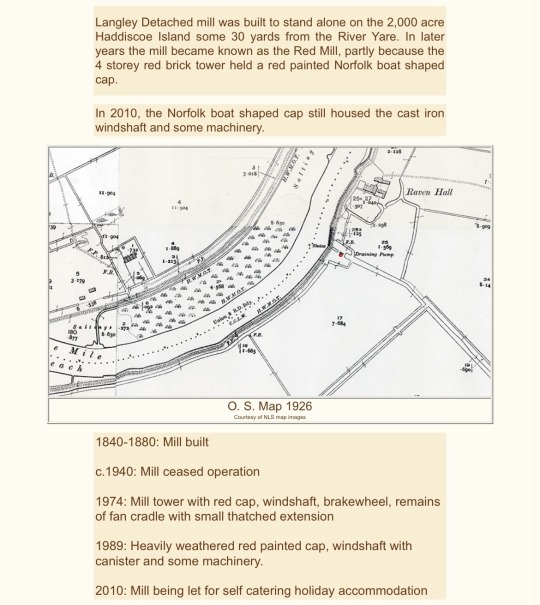
They are in an area northeast of Haddiscoe village, called Haddiscoe Island (these days), thanks to a canal added to connect River Yare and River Waveney farther inland, creating an island of the area and making the marshland there more remote/less accessible.
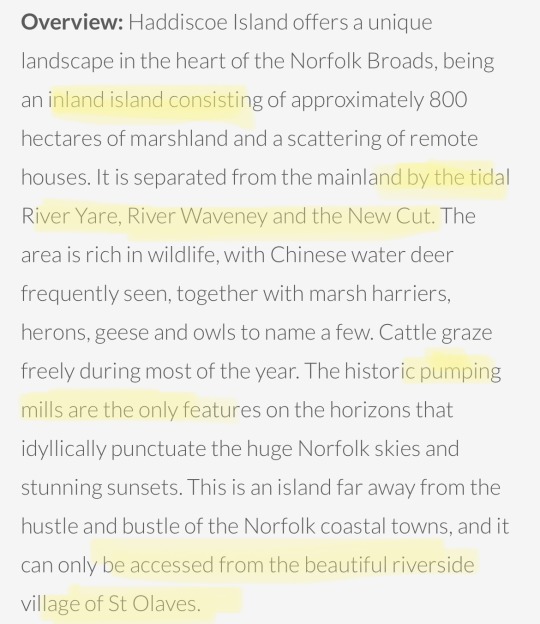
There's a historic farmhouse just east of River Yare, not far from Red Mill, called Raven Hall. And Raven Hall would be a premium location to have a secluded facility like F. O. L. Orphanage.
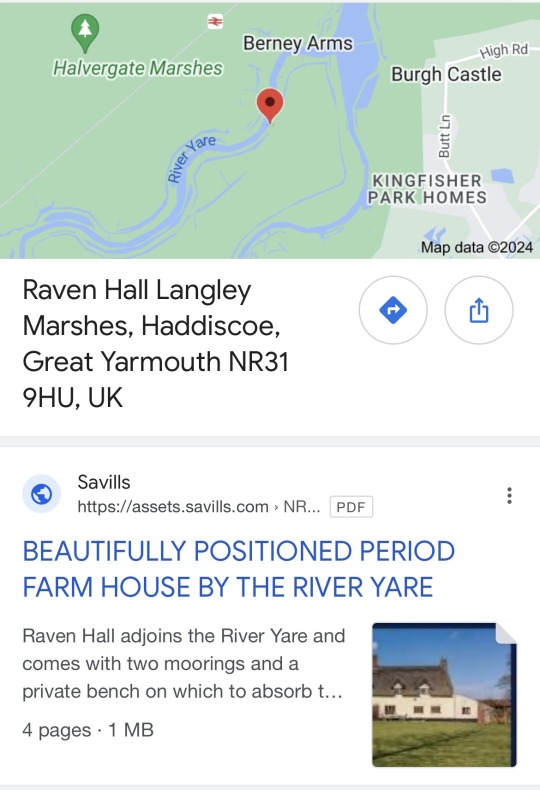
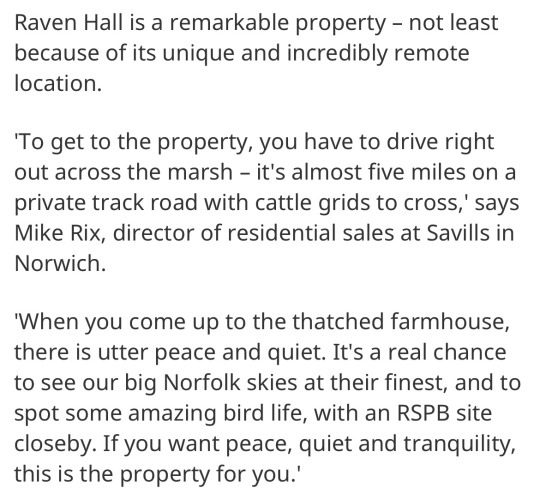
There's only one thing I don't like about the buildings shown for Raven Hall -- it's a bit farther from the drainage pump than I want it to be, and it's just a large farmhouse (almost 3000 sqft) and a long barn (almost 900 sqft). But there's a cool space just south of those buildings, which would be ideal for the main orphanage, as well as a spot for the stables/barn leading closer to the drainage pump, farther south. Here are two options for the placement of F. O. L.:
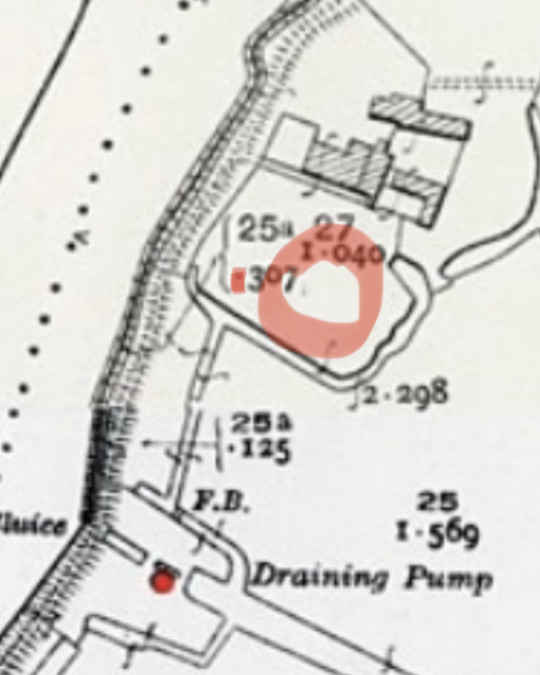
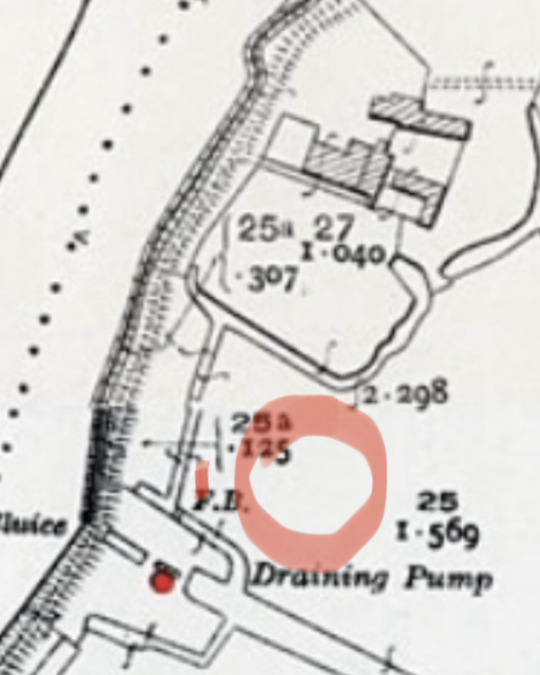
In each case, I've placed the stables to the west of the main house, as a small red rectangle (more or less), while the windpump was already marked by a red dot farther southwest. Looking at the bend of the river on Theo's image of a map of the place, the placement on the right (above) might be the better match. Then again, it could be exactly where Raven Hall is located. And Raven Hall, having been built in the 17th century (or at least 1700), is older than Red Mill (built in 1840).
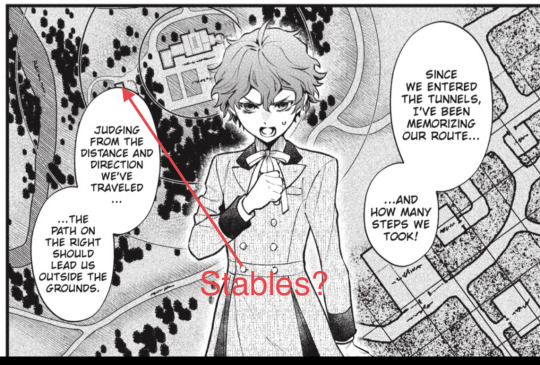
Too bad I can't see the placement of the windpump on his map, but I think it's somewhere behind the speech bubbles on the left side of the panel.
We see that the windpump at the orphanage has a low roof of some kind, and juxl25 explains that someone was probably living onsite just to maintain it full time. I did find at least one pic showing Red Mill with what could be the old maintenance shed/shelter, but it seemed to be on the wrong side. Who knows? I guess it depends on which way the sails are facing to catch the wind? But the low roof in the panel is probably just the top of some shed.


Oh, and near St Olaves, there's a train station called Haddiscoe Station. They could have got off the train there and made their way north to the orphanage by foot. Or did they hitch a ride part of the way? I'll have to go back and check.
I'm still considering one other location, not far from there, but I won't post it unless further research looks more promising.
Hey... can you imagine if all this time... F. O. L. was just some place name reference... like "Farmhouse on Langley" (Marshes)?!?
Please let these kids break the windpump and flood the tunnels.... 🙏
#black butler#kuroshitsuji#ch210#real places#historical references#norfolk#haddiscoe island#langley marshes#red mill#langley detached drainage pump#langley detached mill#langley detached windpump#theo#theodore#raven hall#theories#ideas#discussion#observation#long post#long reads#mar 19 2024#haddiscoe station
34 notes
·
View notes
Text
Hurricane Ian did a number on my neighborhood. We had over 24 hours of heavy rain, more than I’ve ever seen from a hurricane in 40 years. Houses a few streets over were under water a couple of inches. We lost a truly distressing amount of grand trees and both of my trees suffered a lot of damage. The storm, technically, didn’t ‘hit’ here and wasn’t forecast to be even half as strong as it was and also didn’t behave in any way it was predicted to which is how you know that what we actually know about meteorology as a science is basically nothing and I’d do well to remember that when these morons start throwing darts at the wall to make their guesses.
Telling the story of a hurricane is a little like telling the story of a party at which you had probably slightly more alcohol than was good for you and then some bozo roofied your drink. Everything is a blur and when you come back to reality there’s this vague sense of unease because you know things went sideways but you’re 200% unsure exactly how.
I need to regrade my lawn, this became apparent when, about hour nine of the hurricane, my pump and french drain could no longer stay ahead of the water pooling in the low spot of the back yard and water got into my lanai and then into my laundry room and studio.
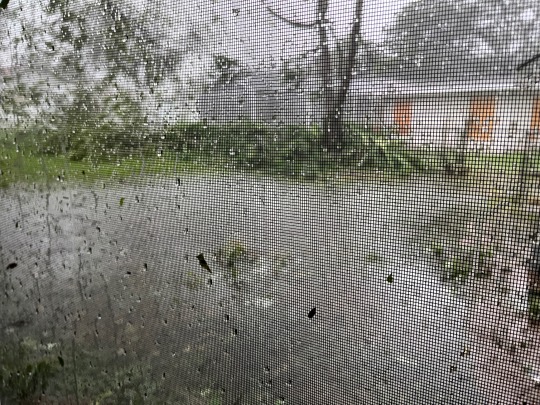
It wasn’t a distressing amount of water, except for the distress of having to mop everything three times. I hope it’s three, I haven’t got as far as three yet but everything’s still dirty.
My neighbor, bless his brilliant working class heart, declared that he’d thought of a way to dig some trenches in my lawn to divert the water out to the street and would I be upset if he tore up my grass? Not nearly as upset as I would be if the water got any higher in my house, go for it, ‘A’. He came back 5 minutes later with a 4 wheel drive pickup and spun the tires out the entire length of my yard. There is mud splattered everywhere but A has proven well over that he’s a good guy to have on hand in a crisis because the water started going down immediately.
Shortly after this my generator conked out.
Somewhere around hour 15 most of the branches blew off my maple tree, A’s tool shed blew down the block and one of the grand trees on the corner blew out by it’s roots, blocking the entire street and also one of the storm drain.

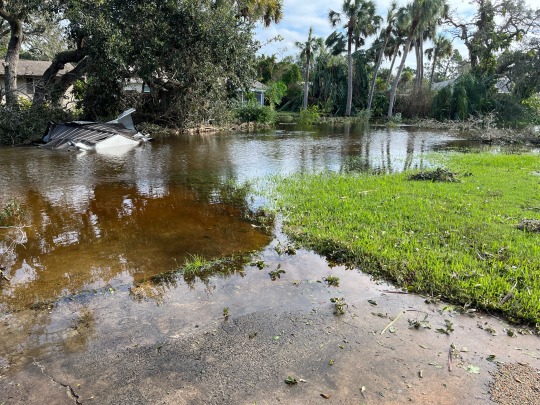
I feel like the folks in charge of our storm sewers maybe need to look at capacity. This wasn’t storm surge. This was flat out more rain than the sewers could handle. The water could have run off, neither the creek nor the canal broke their banks and that means we would have had less damages to both people and plants with better drainage, something to take up with the local government I think.
At about hour twenty two I completely freaked out because that’s when the cell phones went down. The power had been out for a few hours by this point but the idea of not even being able to see where the hurricane currently was and how much longer it planned on hanging around sent me right over the deep end. I’m generally really good with the contingencies but I’m not really good when plans A through G go completely FUBAR. I do not have any ideas for a plan H, I’m currently taking suggestions.
When the storm finally passed there was water almost knee deep in the street. There were actual schools of minnows in my driveway
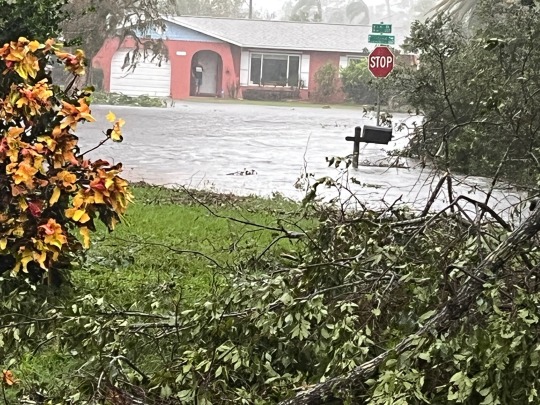
My least favorite part of any hurricane isn’t the hurricane, it’s the cleanup after the hurricane. Cleaning up with no electric and way more mud than is healthy isn’t fun. But on the up side I live in an awesome neighborhood and as soon as the wind died down everyone was out starting in on the worst of it. One of A’s kids cleared the small debris from my front lawn and I cleaned out another neighbor’s fridge so it wouldn’t form sentient life. And one of the neighbors farther down the street brought his skid steer down and pulled the tree out of the street and away from the sewer. We do a decent job of looking out for each other. The Pub on the corner didn’t have power but they fired up the gas griddle and made $10 dinners to clear out their fridges before everything spoiled.
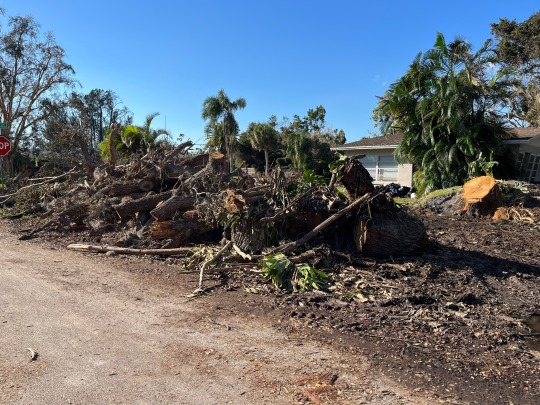

This wasn’t actually the worst storm I’ve ever done. (That was the blizzard of ‘78) It’s not even second place. It was the longest and I found myself at several points wishing for storms more like Hurricane Charlie. It’s been a week and a day, I got electric back last night and internet restored today and right now I’m sitting on my couch in the A/C watching Mythbusters reruns. So I guess I can’t complain.
A few places around town are going to have to work hard to get back to normal, including the Venice Theater.
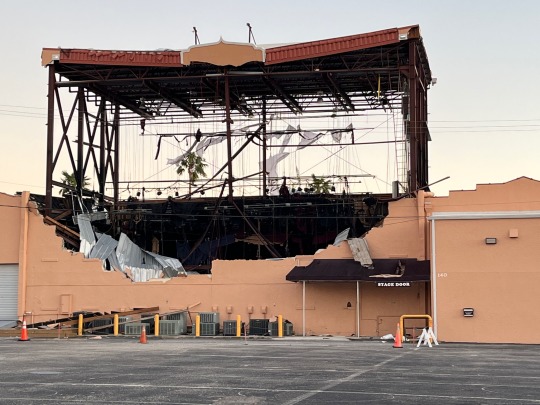
but we’ll do what we always do. Another week of cleaning and the fundraisers will start. I’m told several groups out of state are already hosting fundraising events for us. I have a list on my fridge of all the things I can do better for next time, so I guess that’s the next step.
10 notes
·
View notes
Text
The Kingfisher Connection
Whilst walking along the towpath of the Kennet and Avon Canal by Darlington Wharf on the edge of Bath, I came across a young woman who was pointing something out to her child. As I approached, she looked at me and said: “Kingfisher!” in an excited but muted tone. I turned and looked and sure enough there was the majestic bird perched on a branch of a bush on the offside bank. The woman and her child moved on; “Thank you so much!” I said by way of farewell. After a few more seconds I too carried on along my way. Another woman was walking towards me, so I passed on the message: “Kingfisher!”, with the associated pointing to gesture in which direction she should look. “Thanks very much!”, sincerely delivered upon spotting the prize.
As I continued on my way, I wondered how long of a chain might be built up before the ‘Fisher moved on, how many people would be treated to a sighting of this elusive creature as well as a brief but meaningful connection with a fellow human being, a shared delight in the beauty of nature.
Anecdotal evidence at its finest, this illustrates some of the depth of the well of wellbeing that is available for us to drink from, a metaphorical spring of sustenance that may not be as essential to life as literal water but one which makes that life worth living. We have it in our gift to ensure that these moments of magic are kept alive through subsequent generations by not only looking after the fragments of nature that we have not yet destroyed but by growing and connecting these remnants into wider and broader and deeper ecosystems where such wonders abound. No-mowing, no digging and other organic agricultural and horticultural practices; daylighting of covered waterways, sustainable urban drainage systems, reclamation of contaminated lands: a full-scale rewilding of all the environments we inhabit will not only give protection to all landscapes and species before they become endangered, but will immeasurably enrich all of our lives, Kings and Kingfishers alike.
1 note
·
View note
Text

Applications of Swamp Excavator [Infographic]
Swamp excavators are versatile machines designed to work in challenging wetland environments, providing a range of applications across various industries.
Here are some detailed applications of swamp excavators:
1. Dredging Operations
Waterway Maintenance: Swamp excavators are used to remove sediment, debris, and vegetation from rivers, canals, and lakes to maintain navigable waterways.
Pond and Lake Cleaning: They help in cleaning and deepening ponds and lakes to prevent eutrophication and improve water quality.
2. Wetland Restoration
Habitat Creation: These machines assist in creating or restoring wetlands, which are crucial habitats for various wildlife species.
Water Flow Management: Swamp excavators are used to dig channels and ponds to control water flow and prevent flooding.
3. Environmental Remediation
Pollution Cleanup: They play a critical role in cleaning up contaminated sediments from polluted water bodies, such as removing heavy metals, hydrocarbons, and other toxic substances.
Ecosystem Restoration: By removing pollutants, swamp excavator help restore natural ecosystems and improve biodiversity.
4. Infrastructure Construction
Levee and Dike Construction: Swamp excavators are used to build and maintain levees and dikes to protect against flooding in low-lying areas.
Foundation Work: They prepare the ground for construction projects in wetlands, such as building roads, bridges, and pipelines.
5. Agriculture and Aquaculture
Irrigation and Drainage: These machines help in creating irrigation channels and drainage systems in agricultural fields prone to waterlogging.
Fish Farming: Swamp excavators are used to dig ponds and channels for fish farming operations.
6. Mining and Resource Extraction
Peat Harvesting: In areas where peat is harvested for use as fuel or soil conditioner, swamp excavators are used to extract peat from waterlogged environments.
Resource Recovery: They assist in the recovery of resources from wetlands, such as clay and sand.
7. Disaster Response and Recovery
Flood Response: After flooding events, swamp excavators are used to clear debris, restore water channels, and repair damaged infrastructure.
Natural Disaster Recovery: They play a role in the recovery efforts following natural disasters in wetland areas, helping to rebuild and restore affected regions.
8. Oil and Gas Industry
Pipeline Installation: Swamp excavators are used to dig trenches for the installation and maintenance of pipelines in marshy and swampy areas.
Site Preparation: They prepare sites for drilling operations and other infrastructure in challenging wetland environments.
9. Forestry and Land Management
Tree Removal: These machines can remove trees and stumps from waterlogged areas, facilitating land management and preparation.
Firebreak Creation: Swamp excavators are used to create firebreaks in wetland areas to prevent the spread of wildfires.
10. Tourism and Recreation Development
Park and Trail Construction: They help in the construction of parks, trails, and recreational areas in wetlands, making these areas accessible to the public.
Marina Development: Swamp excavators assist in the construction and maintenance of marinas and boat ramps in swampy regions.
In summary, swamp excavators are essential tools in various industries, providing solutions for tasks that require operating in difficult wetland environments. Their unique design and capabilities enable them to perform a wide range of applications, from environmental remediation to infrastructure construction and beyond.
For more information about Swamp Excavator, click here www.riverexcavator.net/amphibious-excavator or call us now +86 15926413148
0 notes
Text
Macaroons versus Monster Trucks

It was the best of times, it was the worst of times, it was the age of wisdom, it was the age of foolishness, it was the epoch of belief, it was the epoch of incredulity, it was the season of Light, it was the season of Darkness, it was the spring of hope, it was the winter of despair, we had everything before us, we had nothing before us, we were all going direct to Heaven, we were all going direct the other way – in short, the period was so far like the present period, that some of its noisiest authorities insisted on its being received, for good or for evil, in the superlative degree of comparison only.
Charles Dickens, A Tale of Two Cities, 1859
Other than the divergence from the myopia of prying apart the isthmus with a sea-level canal Washington also bested its fleur-de-lys counterpart with superior technology. The suite of machinery in America’s inventory had a material effect on the alacrity with which regolith and rock was removed from the bed of the waterway. Mythologized as a Goliath of steam and steel the Bucyrus dragline weighing ninety-five tons weathered the wear and tear of construction for a decade as it bent nature to its will. Sporting a bucket to accommodate five cubic meters of spoil with each bite into the ground and whose efficacy boasted a fivefold increase in productivity versus any French copy the machine expedited work by orders of magnitude (Parker 2009: 464). An army of these giants sitting atop rail tracks led the mechanized assault on the 50-mile trench together with a phalanx of trains in the vicinity of 160 each day which hauled the muck out to build the Gatun Dam. This grist sourced from the dig impounded an artificial lake that would later feed the lock system with a steady supply of water to make the Canal’s passage uninhibited. The bespoke Bucyrus made uniquely for this project pared down labour-intensity when the behemoth manipulated 4,800 cubic yards of material each day bereft of protracted downtime (Ryckman 2018).

Seven shovels of earth filled a rail car in under ninety seconds or forty-five minutes for a whole train whereby locomotives were kept in perpetual motion when each outbound trip greeted an inbound one (Rogers and Magura 2018). Such continuous kinetic energy militated against any gridlock which might cripple the venture’s lead time. This cavalcade of twenty buckets on four wheels that vacated ground zero took two hours to complete a circuit between the dumpsite and worksite (Giroux 2014). As the railroad expanded piecemeal into the inhospitable terrain a slight gradient always exploited gravity to help the departure of trains laden with rock and rubble. This innovation equally allowed for drainage to keep the roadbed dry for the maze of tracks crisscrossing the Panamanian jungle. Where the French most acutely erred was in their logistics which saw a mismatch between the mounds of earth removed and their disposal. By contrast Chief Engineer John Stevens devised 450 miles of railway akin to a Jackson Pollock painting of lines zigzagging the geography to move dirt apace with the brisk clip at which it was dug (Keller 1983). Automobiles were alien to this world as man and material moved exclusively by the monopoly of rail. A robust network for egressing detritus from the Canal was not an afterthought this time around.
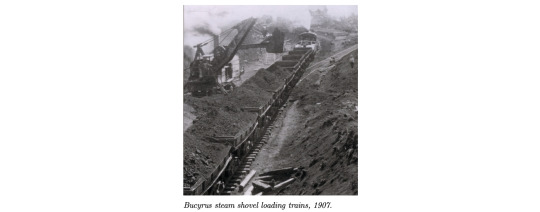
Over the life of the project seventy-seven Bucyrus and twenty-four Marion shovels laboured tirelessly on cleaving a path through the wilds of Panama. In tow with these metal workhorses were track-shifters that exhumed old rail and plopped it down anew as the ensemble of men and machines invaded deeper into the thicket of jungle. The genius of plying trains this way to scaffold the Panama Canal lay in the relentless momentum when a dozen men partook in the migration of track with haste versus the six hundred under past French fiat. Such innovation crimped labour and time to maximize productivity as idleness was anathema to progress. The systematic use of rail in the supply chain equally gave vent to a nocturnal character where by day the drums of industry boomed and by night a bouquet of workers commuted onsite and tended to the machines for repair and restock of coal. Things were always astir and never asleep. The lion’s share of controlled demolition also coincided the evening hours or midday breaks when the flight of personnel transformed worksites into a tabula rasa for Dupont dynamite. Thirty-six years after Alfred Nobel unlocked the power of nitroglycerine this substance evolved into the sine quo non of operations insofar as sixty-one million pounds of it blasted asunder the isthmus (McCullough 1977).
The Canal emblematized the jewel of empire when the might of industry descended upon this barren strip of land. As America rode the crest of the Industrial Revolution amidst the heyday of the Gilded Age with mechanical juggernauts of great calibre the project hurried along in earnest. The Cartesian method of excavation proceeding in lockstep with disposal across a constellation of fixed capital was the single most salient innovation. Pneumatic drills amongst this lot further guaranteed time was a commodity well spent which the economies of $22 million below final budget estimates evidenced (Rogers 2014). Compressed air plants of vast dimensions attended to these rigs whose boreholes at a maximum depth of fifty feet accommodated strings of dynamite. Over 725 of these contraptions perforated the landscape to fracture stubborn rock. Both churn and well drills powered by coal counted themselves amongst the company of tools used along the route as well (Giroux 2014). A choreography of diggers, blasters and haulers thereby manifested into the mainstay of this gorge linking the Atlantic and Pacific. For a measure of perspective more explosives found use in the throes of this project than the sum from America’s wars hitherto. The efficiency wrought by dynamite was made famous in the Culebra Cut.


For the Americans just as it was for the French this nine-mile stretch of dirt hung the Sword of Damocles over the Canal’s prospects. A quarter of expenses or $90m financed this chapter of excavation alone (Rogers 2014). Heavy rains waterlogged the site which landslides compounded by engulfing the lowest-hanging fruit of equipment too ponderous to escape. What made this tranche of work most daunting was the heterogeneity of soil. The unstable geology of soft shale coupled with sandstone at the Canal’s highest elevation wrought havoc on the exigency to remove 96 million cubic yards of material from the Continental Divide. In fact this very conundrum which defeated the French a decade prior would spur the creation of the Bucyrus steam shovel in its 95-ton and 105-ton incarnations as a sui generis remedy to the spectre of failure. Bref the Americans simply engineered the problem away. Whereas Paris sought to cross the isthmus with a minimal amount of digging the buccaneers in Washington set upon doing the most. The former being partial to minimalism and the latter plumping for maximalism evokes the popular stereotype of the disparity in preferences for either country: a dichotomy of macaroons and monster trucks. Facts do countenance this bon mot since France cleared 78 million cubic yards versus the 246 million by the Yankees (Herndon 1977).
0 notes
Text
The Role of Excavation Equipment and Tractor Scrapers
In the realm of agriculture and construction, excavation equipment and tractor scrapers play indispensable roles. These versatile machines are the workhorses behind various essential tasks, ensuring that projects are completed efficiently and effectively. Let's delve into their roles and significance in these industries.
Excavation Equipment in Construction:
Excavation equipment, including excavators, backhoes, and trenchers, are vital tools in the construction sector. Their primary function is to dig, move, and reshape the earth. Here are some key roles they play:
1. Foundation Digging: Excavators are used to dig trenches for building foundations, ensuring stability and safety for structures.
2. Trenching for Utilities: They are crucial for creating trenches to lay utility lines such as water, gas, and electrical cables.
3. Land Grading: Excavation equipment helps in leveling and grading the ground to achieve the desired slope or contour for construction projects.
4. Demolition: These machines can efficiently demolish existing structures, making space for new developments.
5. Excavation for Pools and Ponds: In residential and commercial projects, excavators are used to create pools and ponds.
Tractor Scrapers in Agriculture:
Tractor scrapers, on the other hand, are agricultural giants designed to perform a wide range of tasks on farms. Their adaptability makes them indispensable for modern farming practices:
1. Land Leveling: Tractor scrapers are used to level fields, ensuring proper water distribution and reducing the risk of soil erosion.
2. Irrigation Canal Construction: They help create irrigation ditches and canals, improving water distribution to crops.
3. Road Building: Tractor scrapers are employed to build and maintain farm roads, making it easier to transport equipment and crops.
4. Removing Debris: They efficiently remove rocks, debris, and unwanted vegetation from fields, enhancing overall crop health.
5. Improving Drainage: Tractor scrapers are instrumental in creating drainage systems, preventing waterlogging in fields.
Significance in Efficiency:
Both excavation equipment and tractor scrapers significantly contribute to efficiency in their respective industries. They reduce the time and labor required for tasks, leading to cost savings and quicker project completion. In construction, precision digging and grading are achieved with speed and accuracy. In agriculture, farmers can maximize crop yields through effective land preparation and water management.
Conclusion:
Excavation equipment and tractor scrapers are unsung heroes in construction and agriculture, playing pivotal roles in shaping our physical environment and ensuring food production. Their versatility, efficiency, and ability to perform multiple tasks make them indispensable tools for professionals in these industries. If you want more such agriculture equipment in Australia, Range Hire is the best option for you.
Originally published at:
0 notes
Video
youtube
Draining the Swamp: The Little River Drainage District
Oct 25, 2021 #thehistoryguy #Missouri #history In southeastern Missouri there is an area of around 1700 square miles that, owing to its shape in relation to the rest of the state, is called the Missouri Bootheel. A little known part of Bootheel history is a project that has been described as one of the greatest engineering projects in American history, at one time the world’s largest drainage project, which moved more dirt than the digging of the Panama canal.
Photos courtesy Courtesy of the Missouri State Archives. https://mdh.contentdm.oclc.org/digita...
This is original content based on research by The History Guy. Images in the Public Domain are carefully selected and provide illustration. As very few images of the actual event are available in the Public Domain, images of similar objects and events are used for illustration.
0 notes
Photo

A bucket dredger in the Florida Everglades, digging a drainage canal in the 1910s. This was part of a campaign to turn the Everglades from “useless” land into profitable farmland. Only 50% of the original wetlands remain.
{WHF} {HTE} {Medium}
57 notes
·
View notes
Text
Drive north on Route 16 out of Hardwick into the tiny town of Glover and you will pass through a graceful, slender valley. If you stop to read the roadside marker, you will learn a startling fact. Two centuries earlier, the spot where you are standing was seventy feet under water. Though there is little evidence of it today, this valley once contained Long Pond. That is, until one day in 1810, when a grievous hydro-engineering blunder gave Long Pond a new name: Runaway Pond. That error put this town on the map by almost wiping it off of it.




… [Aaron] Wilson had what must have seemed like a good idea at the time. If Mud Pond, which fed the Barton River, wasn’t providing enough water, he’d redirect Long Pond so it flowed into Mud Pond. Then his mills would have plenty of water. He ended up getting more water than he bargained for. On June 6, 1810, Wilson rounded up sixty men, and they started digging a small canal to coax Long Pond to flow north instead of following its southerly drainage
The pond’s two billion gallons shot through what had grown into a two-hundred-foot gap. The flood hit Mud Pond below and took all of that pond’s water, too. Picking up boulders and trees as it crashed forward, the flood’s leading edge presented a forty-foot wall of water. People downstream in Barton heard the growl and thought it was an earthquake accompanied by thunder. But one witness on a hillside saw what was happening: “The forest from Glover was coming down upon Barton.”
The water obliterated the gristmill. It also destroyed two sawmills, a blacksmith’s shop and five bridges. The flood carried away a horse and numerous sheep. As it flowed, the flood discarded thousands of trees and boulders covered by mounds of dirt in surrounding fields. When the waters reached Lake Memphremagog about six hours later, they allegedly raised the lake’s level a foot and sent panicked fish swimming up its tributaries. Thanks to luck, or to the fact that Glover was sparsely settled in 1810, or to Chamberlain’s speed, no one died in the flood. The aftermath of Aaron Wilson’s little project, however, is still felt in Glover. Homeowners in some parts of town have reportedly had trouble digging foundations. Once they reach a depth of about five feet, they hit a layer of downed cedar trees—evidence of Long Pond’s sudden demise.
Excerpts from: Hidden History of Vermont by Mark Bushnell.
8 notes
·
View notes
Note
Given that the trident seems to overflow quite regularly, wouldn’t the riverlands be better off digging small canals controlled by sluice gates to limit water supply and allowing them to refill the rivers when necessary?
Drainage canals as a means of irrigation and flood control wouldn't be a terrible idea.
12 notes
·
View notes
Text

Today's Flickr photo with the most hits is one taken in the penal barracks at Birkenau. It shows a mural painted in 1942 /43 by that penal company who were, under the most brutal conditions, digging a drainage canal / ditch on site - this is the Königsgraben.
The mural is an unusual survivor and shows a fairly uncompromising view of what conditions were like. It also demonstrates an undeniable pride in the achievement.
#auschwitz#birkenau#konigsgraben#drainage canal#ditches#penal company#political prisoners#red triangle
2 notes
·
View notes
Text
so. just like - updates, overview, mood, what im trying to deal with, lowkey venting
ending week 7 of school (out of 10) and im so glad that both classes are rly laid back bc i am struggling sfm with everything lately. and i mean, spanish is still challenging bc its a whole different language, but it’s a very familiar challenging and the prof, for all her faults, is a soft grader which i appreciate.
im a lot calmer about the kitten situation bc even tho (stray) momma cat had five kittens this time, good!neighbors helped last year and have been involved with me thru momma cat ever since, and im a lot more familiar with what to do. for instance, i didnt panic and temporarily steal all her babies at fair injury to myself only to research, see that they should be with their mom at this age, confirm it with the vet, then let them go right back outside lmao. instead im just leaving them with her but beginning to interact with them. and im sure the neighbors socialize them, too - after all, they’re mostly on/under their deck and who wouldn’t want to play with tiny kittens?
and yall, they’re so fucking cute im ;;;;;; one gray, one pure black, one tuxedo like its mom, and two tortoiseshells, one with a black splotch right on the middle of its face and nose ;o;
and in less fun but still good-ish news, i think i got the one concession that since alcohol has become such a big trigger of mine, if my brother is going to drink he has to be kinda subtle about it, ie no beer cans left in the sink for me to wake up to and feel like ive been punched in the gut literally first thing in the morning (:
actually bc ive been so triggered by that (it’s been going on for like 4 days as of yesterday) i had a Ton of anxious energy and, in part bc ive been needing to anyway, rearranged my room p significantly. but now im on my desktop at my actual desk instead of trying to work on, literally, a folding tv dinner tray. but my 10g aquarium was on my desk and its a pain to move - still, it was one of those rearrangement sessions where after u move one thing u see how another thing should be moved, and it all works out really well. the new location for the 10g is so close that i was able to slide it over and have it rest at one point on both surfaces
im still exhausted and still fighting so many different things, health, stress, etc. - but i have my root canal appointment on monday (finally!) and while, like, the tooth is already dead and a drainage point has developed naturally, both of which mean im not in pain, its still an ongoing infection and that’s Not Great for anyone and esp for my immunocompromised ass. so, yeah, looking forward to that. also bc it’s a complicated root canal job (my root splits midway and has two ends, and it’s one of my front teeth! even tho it’s a pain, neat) i need to see an actual endodontist, but im honestly p excited abt that bc endo is my personal favorite dental specialty and it’s so cool. i love watching them work? even when they’re working on me?
im gonna run my name & gender change forms done to the courthouse this upcoming week, and im rly excited! and nervous! i don’t think i have much cause to be, like i think it’ll go thru without a hitch, but official paperwork of any stripe makes me hella nervous
but also i have been... rly relieving my past a Lot lately. some of u may’ve seen me mention this in now deleted posts but just, yeah, i think everything that’s going on just stirred up all my old traumas and i cant rly ignore it anymore, so im thinking abt getting a therapist of some kind, more just to have someone external to the family and not, yknow, tumblr to talk to abt all this. even dug out my DBT handbook, which should say a Lot abt my state of mind bc that thing was a pain to dig out and it’s heavy and unwieldy (and great, and written by someone with BPD, and great and personally completely revolutionary and did i mention great?)
but the garden and all the growth and the birds and squirrels and bugs and everything else makes me feel so calm, so connected to smth a lot greater and vaster than my household or immediate family or the stressors (living) downstairs, which helps.
2 notes
·
View notes
Text
Barangay Interview and Community Walk
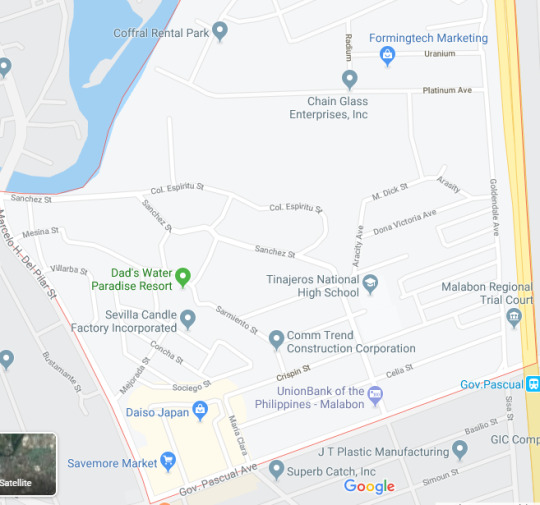
Our NSTP’s final requirement for this semester is to conduct a Barangay Interview and Community Walk where we would have a chat with a barangay official who is in charge of Barangay Disaster Risk Reduction Management (BDRRM), ask them if my barangay is ready when disasters strikes, and explore my community where disasters would be detrimental to each and everyone, the most susceptible, and the safest place to go when a disaster will, has, and had strike.

I invited my father’s good friend (my dad works at our barangay) to our house, Mr. Mario Rances, because he is the head of the BDRRM and asked him a couple of questions whether our barangay is disaster ready and if it can help its citizens in rising again despite the casualties. I asked him where would disasters greatly impact in our barangay when flood, fire, and earthquakes happen. I asked him these because our barangay has many informal settlers in it and not all houses are made of stones, so fire’s could spread quickly, flood’s can destroy houses, and it can make evacuation or escape hard or impossible because of panicking people.
He said they usually gets info from our main LGU, Malabon City, about the incoming disasters than can affect our barangay. And it is also a common practice in our community when there are violent winds, no birds flying, and no stars at night, an incoming hurricane or hard pouring rain is on its way so our barangay usually gives announcement for evacuation. My barangay is prone to floods because our barangay is the catch basin of every barangay in Malabon and the improper waste management of our community which clogs the drainage, so that even if rain pours, even just a drizzle, there would be flood.
And he mentioned the streets that are vulnerable to these:
Flood - M. Dick St., Sanchez St., Espiritu St.,

M. Dick St.
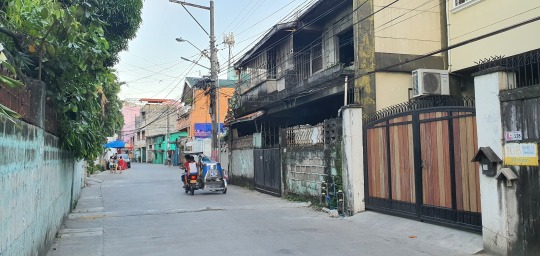
Sanchez St.


Espiritu St.
He mentioned these streets in susceptibility to floods because these are the catch basins of the waters coming from the higher places from our community.
Fire - Espiritu St., Kaingin St. (I & II), Bustamante St., M. Dick St. (Avha), Gov. Pascual (Barrio Makike)


Kaingin St. (I & II)

Bustamante St.

M. Dick St. (Avha)

Gov. Pascual (Barrio Makike)
These places are susceptible to fire because the houses are very congested and are made of light materials which easily catches fire and are highly flammable. These are where the informal settlers settle.
There was a fire on both Espiritu St. (Riverside) and M. Dick St. (Avha) where there are reportedly 50-70 households are affected and 5 deaths are reported at the Riverside incident.
Earthquake - M. Dick St. (Avha), Gov. Pascual St. (Barrio Makike), Kaingin St. (I & II)
As he stated earlier, these are the most affected when it comes to escaping due to narrow pathways or exits. Because when disaster strikes, its man for themselves. They would focus on getting out there alive and not care about other people.
These disasters affects the marginalised in our community because most of them relies on every day wages (jeepney and tricycle drivers) so that they can feed their whole family. So if they did not pasada on that day, they could not feed their family for today. They would resort to being in debt to sari-sari stores to buy their food for that day.
He stated that there are safe places against the disasters awaiting to come to our barangay. Because these places are the highest places in our barangay, the houses in there are made of stone or materials not that flammable, or the houses are far apart. These are the places he stated:
Flood - Gov. Pascual St., Sisa St., Celia St., Cripsin St., Kaingin St. (I & II), Bustamante St., Villarba St.

Sisa St.
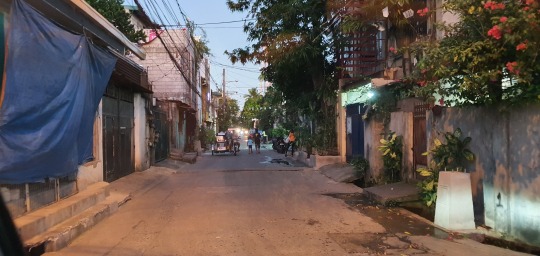
Celia St.
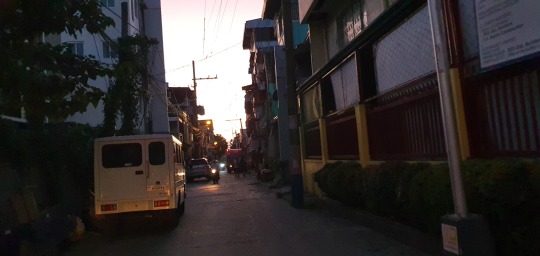
Crispin St.
He stated that these streets are found in higher parts of our barangay which makes them less susceptible to floods.
Fire - Sisa St., Villarba St., Crispin St.
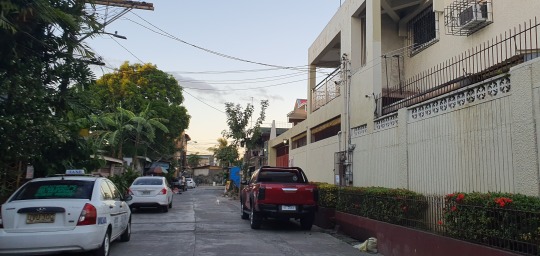
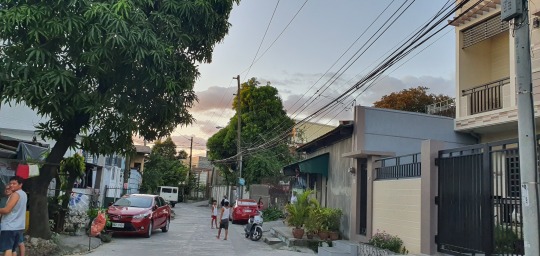
Villarba St.
These places are not susceptible to fire because the houses found in these streets has a fire wall (a wall that blocks fires from spreading), houses made of stones or materials that are less likely to catch fire, and each house has spaces between them, they are not congested.
Earthquake - every street
He told me that every street in our barangay is almost safe because we don’t have high rising homes (usually up to 2nd floors) so evacuation and exit is easier and our barangay is not in the fault line.
The problems that our barangay has faced are high levels of floods, the lack of equipment to help (they have help from the DRRM but there are other places that also needs help, sometimes they are the ones that need more help than us), lack of help from the residences (making their homes as shelter for others, food, clothing, etc.), the lack on quick response and relocation sites (barangay, barangay court, barangay multi-purpose hall, and Tinajeros national Elementary and High School Campus) because these places cannot accommodate every resident that needs relocation in our barangay.
Mr. Rances told me that our LGU has recently mandated that each barangay of Malabon should document and show the equipment available for the incoming disaster which then are evaluated if it is enough to help each and every resident the barangay is covering and if it can work perfectly and efficiently. Our barangay has complied to the evaluations required by the Malabon Council which requires our barangay to have e.g. life vests, rubber boats, and signages (where it states the fault line, relocation area, where is it safe to pass, etc.) and our barangay has the Tinajeros Fire and Rescue and Tactics, a team or department of 20 volunteers and more that reponds to disasters and helps in rescuing those who are in need of help during disasters.
Our barangay has a calamity fund which is enough to support the families affected of these disasters for their food during and after the disaster and some monetary help for them to start anew if ever they are greatly affected by it. They also plans ahead if ever the disaster occurs, where would be the relocation site for affected families, estimated affected families, where would they start for the search and rescue, where they would pressure the residents to leave their homes for relocation, and their hotlines and phones (the barangay council and tanods) are always ready to answer for help.
Our community helps hand in hand if disasters strikes, where we would help other families to put their household appliances to an upper floor or ground and we cook more food so that we can share it with other families affected by disasters, but the barangay council and staff and tanods are the ones that direct us where to go for safety, what to do during disasters, and helping us keep calm and tell us everything will be alright because they got everything planned.


This is the Riverside I said that was burned down by the fire, there are houses built on there again after a few months even though our barangay has relocated them somewhere else. They said that this is where their life was, where they work, it would be hard for them to relocate because they would leave their life in here. They would prefer to live in this unlivable place (no drainage, illegal settler) than to live in a place where they would not be scared because their house is made of stone and would not be easily destroyed by any disaster.
The safest places would be in the Villarba St. out of every streets in my barangay, because this is on eof the most highest place in our barangay and most houses are made of stone, and there are apartments available here that a family of four can live in. So one can live in there safely and comfortably.

I’m proud of my barangay for this, they are upgrading our roads and canals. They upgrade our canals by digging them deeper so that it can accommodate more water. They also has a clean-up drive for our canals, implements strict segregation of trash, and has a daily dump truck that picks up trash from the residents, where each places has a specific day for the dump truck to pick up their trash like the coding scheme for vehicles.
For me our barangay is disaster ready and we, the residents, know what to do when disaster strikes because we are briefed by our barangay on what to do if we are affected. But mostly each and everyone of us should have discipline to lessen the impact of these disasters. Never throw trash anywhere to not clog or fill the canals with trash, listen to the news about the hurricanes and earthquakes, always unplug electrical devices when not in use to avoid fire, ALWAYS be careful when using fire (for cooking, candles), evacuate immediately when told to evacuate the premises, and follow the safety guidelines (duck, cover, and hold, stop, drop, and roll, don’t go near electrical devices when there is flood, etc.)
No one wants to live in a house where they do not feel safe and comfortable but the people that live in these dangerous places cannot live or move to a different place because they do not have the money to move. They are compromising because this is the only place they could afford to live in with their wage. Even if they want to move, they can’t. Honestly, our barangay is helping my community in anyway they can to prevent these disasters affect them greatly, but for me I would implement a kind of starting business for these families so they can afford to move or improve their houses. If not, they can offer some help in making their houses more less likely to be destroyed by disasters. But every Filipino also experience this, the want to live on a better place but they cannot because of their circumstances. I demand for the Government to help the marginalised in making their homes safer for them to live in, to use the donations and funds given to them to help the affected families and not to put it in their own pockets or eat it happily with their own family. They are put there by the Filipinos because they trust them that they would help in times of need.
During my interview and community walk, I cannot help but to feel thankful. A 2nd child born to a middle-upper class family. Someone who can afford to go to a prestigious school, eat 3-times a day, and sleep in a comfortable bed. That the house I live in is safe from disasters, i can sleep during the hurricane and flood without ever thinking we should get out of here because our home is washed away by the flood, sleeping soundly that our house are made of stone and nonflammable materials. The things I took for granted which other families would kill to have, that I was blessed to live in this kind of house. So for me to pay it forward, I would help in any way I can, the people who needs help during disasters. That by not throwing candy wrapper on the street would be a big help for our community to not get easily flooded.
We live in a 3rd world country dominated by the marginalised. Where sleeping in the road despite high floods and heavy rains is common. This should be an eye opener to everyone, not just the government. That our country can never move forward because most of us are living poorly. That until the rich cares, the poor will always be poor whatever they do and even if they work harder. That until the lyrics of the songs “Tatsulok” by Bamboo and “Upuan” by Gloc 9 feat. Zelle are relevant and rampant in our country, we WILL always be a 3rd world country.
3 notes
·
View notes
Photo

Gaineswood Plantation
Alabama
The first Gaineswood plantation house was built in 1843 by General Nathan Whitfield, a year after he purchased the 480 acre property, though the first house was simply a large log cabin.
Before Whitfield owned the land it was the site of a rather historic event in the nation at the time. The previous owner, Edmund P. Gaines met with the famous Indian chief pushmataha under a large oak tree, to negotiate the removal of Choctaw forces back to Indian territory. The tree they met under became known as the Pushmataha tree.
When Whitfield owned the estate he made his fortune from cotton farming, for which he bought many slaves that lived in small houses on the land. He was known to be a typical plantation owner when it came to slaves, treating them badly and working them too hard, which included making them dig a huge drainage canal during the summer months.
When Whitfield first bought the estate it was known as the Marlmont estate, though it was renamed in 1856 to its current name in honor of General Gaines, the man who sold it to him. Soon after this the present structure began to be built in the same place as the log cabin.
It was completed on the eve of the American civil war and remains to this day the finest plantation house ever built in Marengo county. Today the house offers tours around its grounds and through the inside of the house and is also open to the general public as a historic house museum.
There probably isn't a plantation house in the south that isn't thought to be haunted, and with good reason due to the horrific treatment many suffered in these places.
The most common source of plantation hauntings is obviously the slaves, but that doesn't seem to be the case here. The paranormal activity in the house is thought to be caused by a single ghost. The most common story is that the spirit is a past nanny called Evelyn Carter, who was buried beneath the house instead of her chosen spot in the family cemetery back in Virginia.
Apart from the odd item being misplaced and the occasional cold spot, the main way she likes to make herself known is by playing the piano. The sound only comes when no one is in the room to see it, but has been heard by many visitors and staff. One interesting thing about the music she plays is it is always very old, forgotten songs that people didn't know existed.
The nearby river is also thought to have provided a few ghosts to the property, making themselves known in the form of ghostly figures moving through the trees or brushing past people walking along the main paths. They are thought to have been from an accident when a steamboat called the Eliza Battle caught fire and killed several people on board.
5 notes
·
View notes